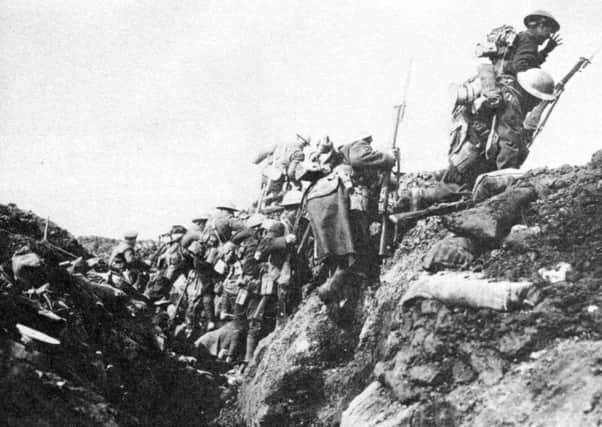Somme '“ the largest military encounter in history


The city had become a symbol for both sides: if it fell to the enemy, French resistance might crumble everywhere; if it survived the German advance would falter and their massive invasion would end in defeat.
For the French it was “Ils ne passeront pas” – they shall not pass – and a steady stream of young recruits marched north to reinforce the defence and die in their tens of thousands.
Advertisement
Hide AdAdvertisement
Hide AdThe fear that the German army was getting the upper hand led commanders to appeal to their allies to bring forward a huge planned attack that would divert German men and armour away from Verdun.
The place chosen was 150 miles west near the River Somme. It was a decision that led directly to the greatest British catastrophe of the First World War with casualties on such a scale that few families in the land remained untouched by the tragedy.
This week marks the 100th anniversary of the start of the battle which was preceded by eight days of bombardment when 1.1 million shells were poured onto the enemy’s defensive positions. The idea was that when the order to advance was given the British troops would cross no man’s land and meet no resistance.
It was a failure on the grand scale.
On July 1, 1916, the men went over the top into a hell of fire which brought a staggering 60,000 casualties on the first day alone. Of these, 20,000 died and by the end of the battle which raged on throughout the summer over 400,000 British troops were dead along with 200,000 French and 500,000 Germans.
Advertisement
Hide AdAdvertisement
Hide AdIt was the largest military encounter in history. Seven miles were gained along a 20-mile front and Verdun survived – but at such a cost!
In Falkirk district, as elsewhere, many families paid the ultimate price. Corporal Andrew Morrison, a 21-year-old apprentice motor and electrical engineer with Thomas Laurie, died on that first day fighting with the 17th Battalion of the HLI. He and his brother Robert from Albert Road are named on the Erskine Parish Church War Memorial.
Lance Corporal Alexander McNeill, a miner aged 24 from Muiravonside, also fell on July 1 with the Gordon Highlanders and as the battle raged on, 20-year-old Private John McLeod, a blacksmith in Abbots Foundry serving with the Argylls, died on July 14 and a week later 2nd Lieutenant Robert Robertson of the Kings Own Scottish Borderers, a 22-year-old graduate engineer from Rosehall Terrace, died from wounds suffered on the Somme.
And there were many, many more whose stories are yet to be told.
This weekend there will be several local commemorations.
Advertisement
Hide AdAdvertisement
Hide AdAt 7.30am on Friday, July 1 in the Bonnybridge Memorial Park there will be a re-enactment of those first attacks followed by a short service in St Helen’s Church and the laying of wreaths at the memorial.
From today (Thursday) there will an exhibition in the Howgate telling the story of the some of the 124 men of Falkirk and Erskine Parish Churches who gave their lives.
And the project to honour the fallen from Falkirk goes on. For example Russell MacGillivray is researching the stories of over 280 men of Larbert and Stenhousemuir whose names are on the Dobbie Hall Memorial.
He is also interested in those who survived and those who were awarded decorations.
If you can help in any way please get in touch with Russell on 01324 553586 or give me a call on 01324 627692.